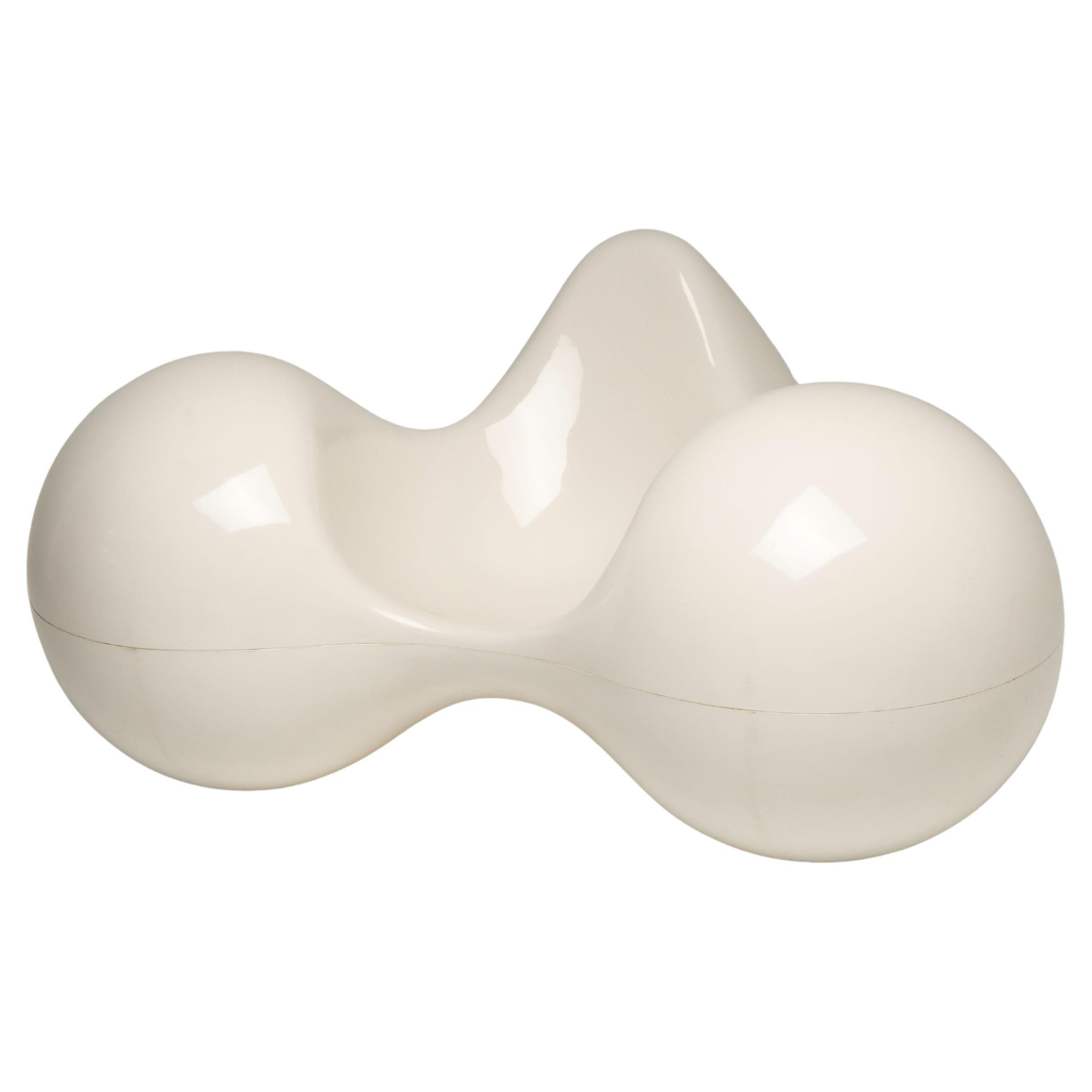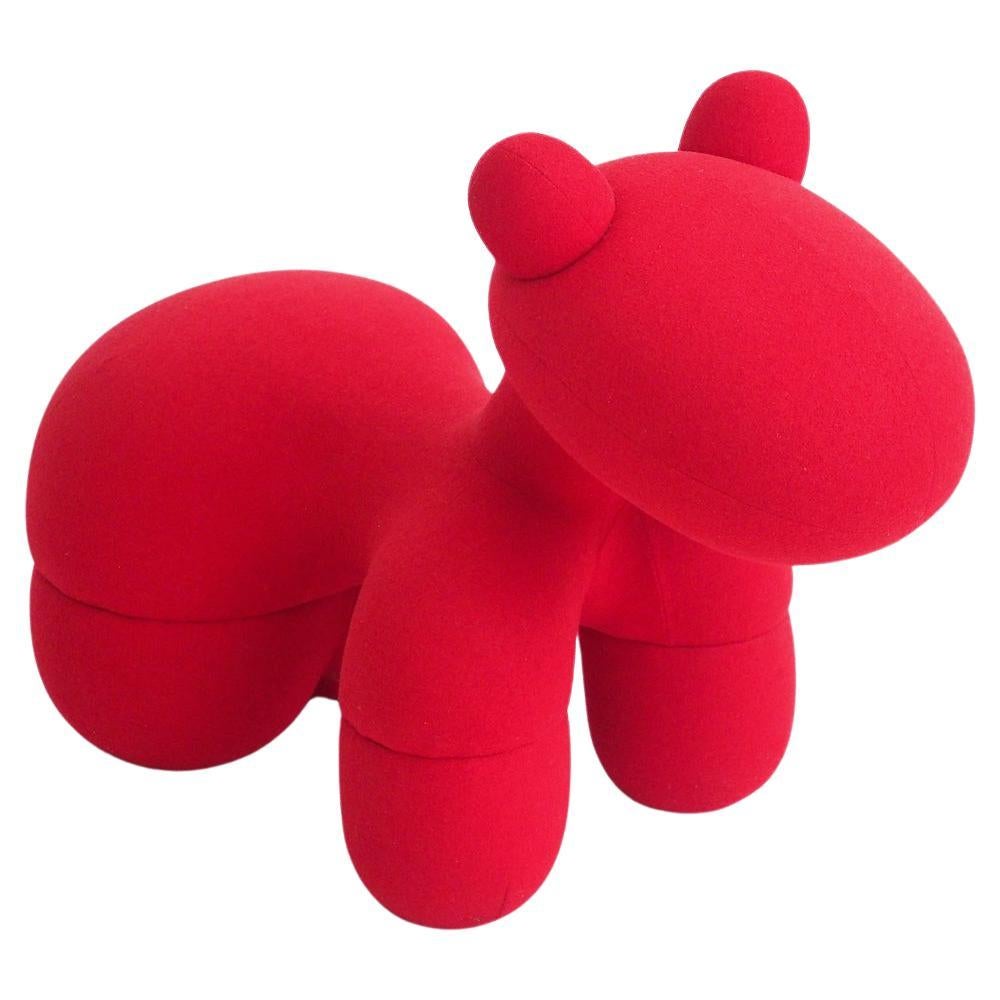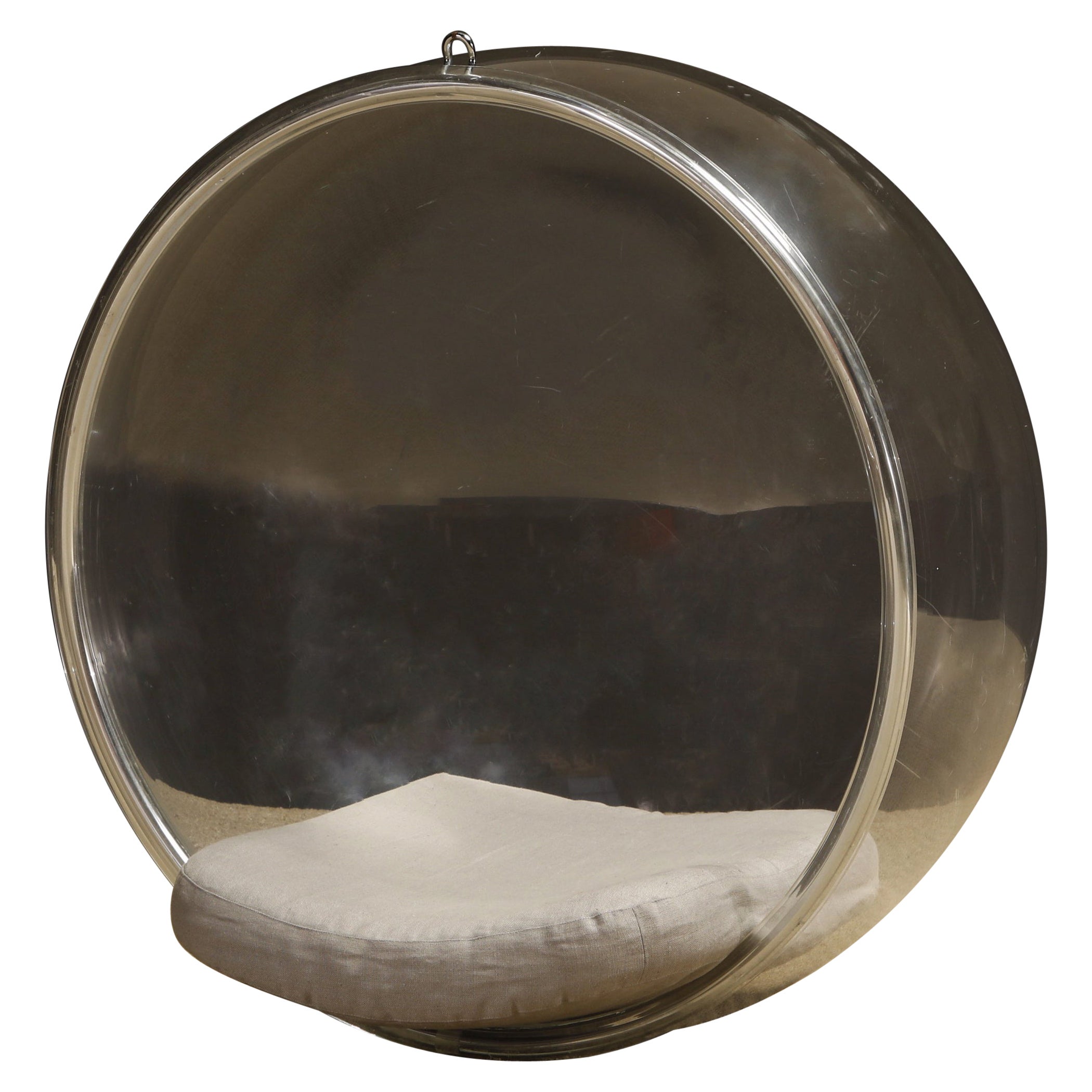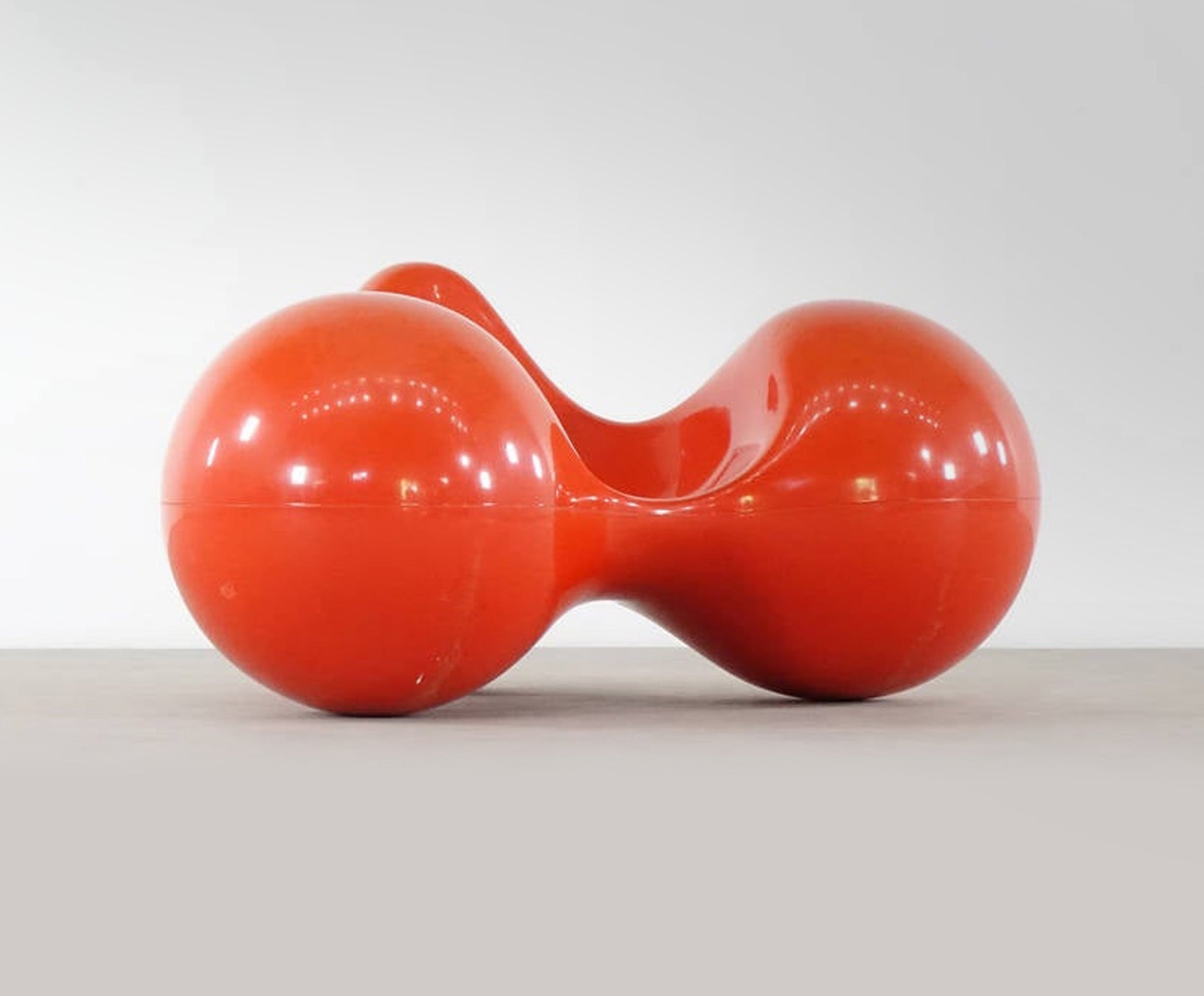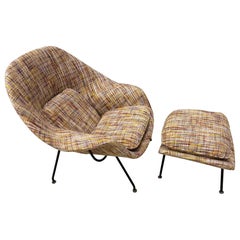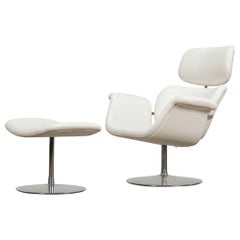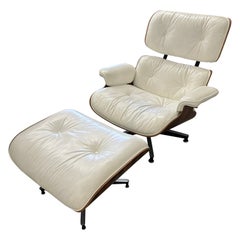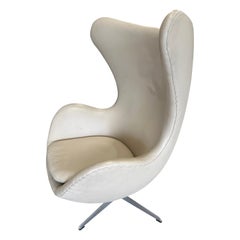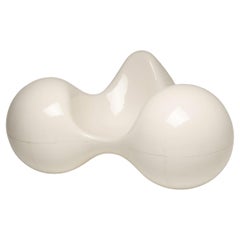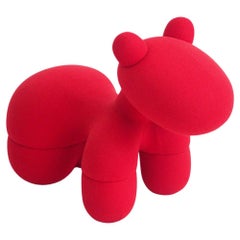Eero Aarnio Tomato Chair in White
About the Item
- Creator:Adelta (Manufacturer),Eero Aarnio (Designer)
- Design:
- Dimensions:Height: 26 in (66.04 cm)Width: 55 in (139.7 cm)Depth: 45 in (114.3 cm)Seat Height: 12 in (30.48 cm)
- Materials and Techniques:
- Place of Origin:
- Period:
- Date of Manufacture:20th Century
- Condition:Wear consistent with age and use. Minor losses. This one is in good condition. We’ve added some felt pieces to the bottom to protect it. There is one small area of nicks on the bottom, pictured. Otherwise very minor scratches and imperfections to the top visible parts.
- Seller Location:Palm Springs, CA
- Reference Number:Seller: Bridges over Time 859981stDibs: LU835041370112
Tomato Chair
In looking at Finnish designer Eero Aarnio’s (b. 1932) big red fiberglass Tomato chair, you can see how it got its name, and it’s not just due to its buoyantly crimson color. As Aarnio explained: “It is named to reflect the two round shapes when you look from the front: like the two circles in the word tOmatO.”
The 1971 chair was one of several in his explorations of circular forms, or designs “without edges” as he put it. It also exemplifies his radical departure from Scandinavian modernism, a movement centered on natural materials and minimalist forms promoted by designers including Alvar Aalto and Aarnio’s mentor, Ilmari Tapiovaara. Aarnio instead preferred the sculptural possibilities of synthetic materials and the use of fiberglass and plastic to create brilliantly colored furniture and design objects.
After studying at Helsinki’s Institute of Industrial Arts, Aarnio opened his own studio in 1962. A year later, he designed the Ball chair. A hollowed-out, molded fiberglass orb set upon an aluminum base, the Ball chair is one of his most revered designs. Aarnio followed this with a suspended version: the 1968 Bubble chair, which is made from transparent plastic. The Tomato chair would take this circle-based seating still further.
The Tomato chair brings together three spheres — all with the same diameter — to make a balanced piece. Two large orbs are used as armrests and one is the back in a form similar to Aarnio’s curvy 1967 Pastil chair. He imagined that the durable piece could not only be used indoors and outdoors but also on the water: “For this I thought ‘a-ha!’ — the Pastil chair floats, it can carry a person across water, but it is not completely stable for this purpose. If I added armrests and a more defined chair back then it would be fun for the water.”
Aarnio continues to find new ways to create playful objects that make fresh statements on design, and today, Eero Aarnio Originals manufactures the Tomato chair. A 2016 Design Museum Helsinki retrospective featured the piece alongside his cactus-like 2001 Double Bubble lamp (cast in plastic) and his 2003 abstracted Puppy, a polyethylene toy, stool and sculpture. Although each offers a spirited take on structure and color, Aarnio has always prioritized function. With its bold silhouette and fire-hydrant hue, the Tomato chair is both a welcoming seat and an expression of how simple shapes can be endlessly innovated.
Eero Aarnio
“I always look ahead, never back,” Finnish design legend Eero Aarnio has been quoted as saying. A leading innovator of modern furniture design, Aarnio has long embraced a bold, playful, confident and colorful style several steps ahead of his time.
For his 1954 entrance test for the Institute of Industrial Arts in Helsinki, Aarnio created a whimsical painting of a man reading a newspaper in a red, curved chair whose silhouette foreshadowed Aarnio’s Ball chair of 1963. That spherical seat skyrocketed him to design fame, and decades later, it is still recognized as one of the world’s most futuristic designs.
Born in 1932 to a house painter and a seamstress, Aarnio has always had a cheerful disposition and an independent spirit. He went his own way early on: After just two years at Asko, the big Scandinavian furniture company that originally produced his Ball chair, Aarnio established his own studio in 1962.
Over the next decade, the young visionary made an indelible mark on the world. Open-minded and entrepreneurial, Aarnio embraced the aesthetics, materials and technologies of the Swinging Sixties, working with a new generation of plastics and molding them into fluid, organically shaped, brightly hued forms.
Introduced at the 1966 Cologne Furniture Fair, the pod-like fiberglass Ball chair soon adorned the homes of movie stars and royalty, graced magazine covers around the world and was featured in films and ads. The groundbreaking seat originally came in orange, white, black, yellow and red and could be ordered with a telephone installed in it. Yet this designer of the future, as he was known in the 1960s, has always insisted that he didn’t deliberately seek to be associated with the decade’s sci-fi aesthetic.
“I had no intention to create either pop or Space Age design — as many people label my work,” Aarnio declares in one of the essays included in Eero Aarnio — Designer of Colour and Joy, a book jointly created by the Design Museum and publisher WSOY to accompany 2016’s “Eero Aarnio” exhibition.
The show featured a number of Aarnio’s objects, including his iconic Ball, Pastil (1967), Bubble (1968), Tomato (1971) and Pony (1973) chairs. These were joined by lesser-known seating and other objects like the rattan Juttujakkara, or mushroom, stool (1960); the sculptural Double Bubble lamp (2000), with which Aarnio first explored the possibilities of rotation-cast plastic; and the three-legged Rocket (1995) and Baby Rocket (2006) stools, both parts of a collection produced by Artek after Tom Dixon, the company’s creative director from 2004 to 2009, discovered the original piece in Aarnio’s kitchen.
“Aarnio expanded the whole idea of what constitutes furniture,” explained Suvi Saloniemi, the Design Museum’s chief curator. “His significance as a designer is crystallized in the liberation of form that he has introduced by discovering the properties of plastic as the material of a designer. His furniture is sculpture-like and eye-catching, but the pieces are always utilitarian at the same time.”
Find an extraordinary range of vintage Eero Aarnio chairs, tables and other furniture on 1stDibs.
- ShippingRetrieving quote...Shipping from: Palm Springs, CA
- Return Policy
More From This Seller
View AllVintage 1960s American Mid-Century Modern Lounge Chairs
Wool
Early 2000s Dutch Lounge Chairs
Steel
Vintage 1970s American Lounge Chairs
Leather, Rosewood
Vintage 1960s Danish Mid-Century Modern Lounge Chairs
Metal
Vintage 1980s American Lounge Chairs
Upholstery
Vintage 1970s Mexican Lounge Chairs
Aluminum
You May Also Like
2010s Finnish Modern Lounge Chairs
Fiberglass
Mid-20th Century Finnish Space Age Lounge Chairs
Fiberglass
2010s Finnish Modern Lounge Chairs
Fiberglass
Late 20th Century Finnish Mid-Century Modern Lounge Chairs
Steel
1990s Finnish Mid-Century Modern Chairs
Chrome
Vintage 1980s Finnish Organic Modern Lounge Chairs
Fiberglass
Recently Viewed
View AllRead More
The 21 Most Popular Mid-Century Modern Chairs
You know the designs, now get the stories about how they came to be.
The Ball Chair, Eero Aarnio’s Space Age Masterpiece, Was Almost Never Made
Now considered emblematic of 1960s mod aesthetics, the Finnish designer's famous creation was far from an overnight success.
